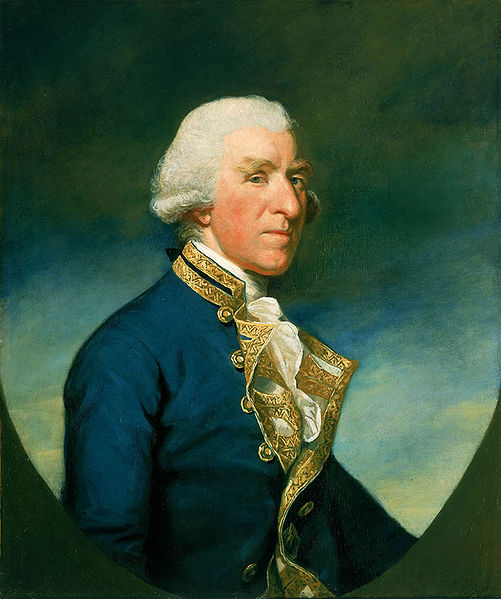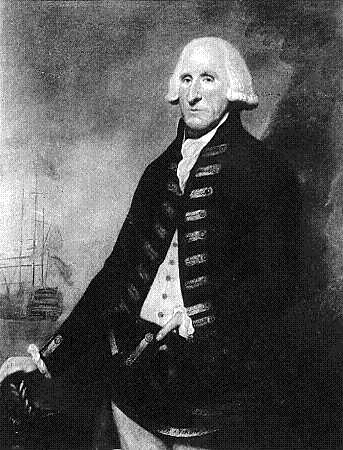<Back to Index>
- Astronomer Sherburne Wesley Burnham, 1838
- Painter Edvard Munch, 1863
- Admiral Samuel Hood, 1st Viscount Hood, 1724
PAGE SPONSOR


Samuel Hood, 1st Viscount Hood (12 December 1724 – 27 January 1816) was a British Admiral known particularly for his service in the American War of Independence and French Revolutionary Wars. He acted as a mentor to Horatio Nelson.
The son of Samuel Hood, vicar of Butleigh in Somerset, and prebendary of Wells and Mary Hoskins, daughter of Richard Hoskins, Esquire, of Beaminster, Dorset. Samuel the younger entered the Royal Navy in 1741. He served part of his time as midshipman with George Brydges Rodney on the Ludlow, and became a lieutenant in 1746. He was fortunate in serving under active officers, and had opportunities to see service in the North Sea during the War of the Austrian Succession.
In 1754,
he was made commander of the sloop Jamaica and served in her on the North American station. In July 1756, while still on
the North American station, he took command of the sloop HMS Lively. At the
outbreak of the Seven Years War in 1756, the navy was
rapidly expanded which benefited Hood. Later that year Hood was
promoted to Post Captain and given command of HMS Grafton. In
1757, while in temporary command of Antelope (50 guns), he drove a
French ship ashore in Audierne
Bay, and captured two privateers.
His zeal attracted the favourable notice of the Admiralty and he was
appointed to a ship of his own. In 1759,
when captain of the Vestal (32), he captured the French Bellone (32) after a sharp action. During the war, his services
were wholly in the Channel, and he was engaged under Rodney in 1759 in the Raid on Le Havre,
destroying the vessels collected by the French to serve as transports
in the proposed
invasion of Britain. He was
appointed in Commander-in-Chief,
North American Station in
July 1767. He returned to England in
October 1770. In
1778, he accepted a command which in the ordinary course would have
terminated his active career, becoming Commissioner of the dockyard at Portsmouth and governor of the Naval Academy. These posts were generally
given to officers who were retiring from the sea. In 1778,
on the occasion of the King's visit to Portsmouth, Hood was made a baronet. The war
was deeply unpopular with much of the British public and navy. Many
admirals had declined to serve under Lord Sandwich,
the First Lord of
the Admiralty. Admiral Rodney, who then commanded in the West Indies,
had complained of a lack of proper support from his subordinates, whom
he accused of disaffection. The
Admiralty, anxious to secure the services of trustworthy flag officers,
promoted Hood to rear admiral on 26 September 1780, and sent him to the
West Indies to act as second in command under Rodney, who knew him
personally. He joined Rodney in January 1781 in his flagship Barfleur,
and remained in the West Indies or on the coast of North America until
the close of the War of American
Independence. The
expectation that he would work harmoniously with Rodney was not
entirely justified. Their correspondence shows that they were not on
friendly terms; but Hood always did his duty, and he was so able that
no question of removing him from the station ever arose. The
unfortunate turn for the British taken by the campaign of 1781 was
largely due to Rodney's neglect of Hood's advice. If he had been
allowed to choose his own position, he could have prevented the Comte De Grasse from reaching Fort Royal with the reinforcements
from France in April. When
Rodney decided to return to Britain for the sake of his health in the
autumn of 1781, Hood was ordered to take the bulk of the fleet to the
North American coast during the hurricane months. Hood joined Admiral Thomas
Graves in the
unsuccessful effort to relieve the army at Yorktown,
when the British fleet was driven off by the French Admiral, the Comte
de Grasse, at the Battle of the
Chesapeake. When
he returned to the West Indies, he was for a time in independent
command owing to Rodney's absence in England. De Grasse attacked the
British islands of St Kitts and Nevis with a force much superior
to Hood's squadron. Hood
made an unsuccessful attempt in January 1782 to save them from capture,
with 22 ships to 29, and the series of bold movements by which he first
turned the French out of their anchorage at Basseterre of St Kitts and then beat off
their attacks, were one of the best accomplishments of any British
admiral during the war. In
1782
Hood took part in a British fleet under Rodney which defeated a
combined French and Spanish fleet which was planning an invasion of Jamaica.
The French commander De Grasse, who had been responsible for the
victory at Chesapeake was captured and taken back
to Britain as a prisoner. Hood
was
deeply critical of Rodney for not pushing home his victory against
the retreating enemy fleet. Had they pursued, he suggested, the British
might have taken additional prizes and destroyed the French naval
presence in the Caribbean. Eventually
Hood was ordered to chase and with his division of 12 ships he captured
4 ships at the Mona Passage on April 19 thus completing the defeat.
While
serving in the Caribbean Hood became acquainted
with, and later became a mentor to Horatio Nelson who was a young frigate
commander. Hood had been a friend of
Nelson's uncle Maurice Suckling.
In 1782 Hood introduced Nelson to the future King William, Duke
of Clarence who was
then a serving naval officer in New York. Hood was
made an Irish peer for his role in the victory
at the Battle of the
Saintes on 9
April and 12 April near Dominica. During
the peace, he entered the British
Parliament as
Member for Westminster in the election of 1784
where he was a supporter of the government of William Pitt
the Younger. In 1786 he became Commander-in-Chief,
Portsmouth, holding
that post until 1789. He was promoted to vice admiral
in 1787, and in July 1788, was appointed to the Board of
Admiralty under
the Second Earl of Chatham,
brother of the Prime Minister. On the
outbreak of the French
Revolutionary War in
1793, he was sent to the Mediterranean
Sea as
Commander-in-Chief. His period of command, which lasted from May 1793
to October 1794, was very busy. In
August 1793 French royalists and other opponents of the revolution took
over the town and invited Hood, whose fleet was blockading the city, to
occupy the town. Hood, without time to request for instructions from the Admiralty in London, moved swiftly to
take command of the port. There
were two main reasons for the British move. It was hoped that Toulon
could be a centre of French resistance to Paris, and also to take
possession of the French Mediterranean fleet of fifty eight warships,
which lay in the harbour. It was hoped that depriving the French
revolutionaries of their maritime resources would cripple the
revolution. He occupied Toulon on the invitation of the
French royalists,
in co-operation with the Spaniards and Sardinians.
In
December of the same year, the allies, who did not work harmoniously
together, were driven out, mainly by the generalship of Napoleon.
Hood
ordered the French fleet burned to prevent them falling back into
the hands of the revolutionaries, a task carried out by Captain Sidney Smith.
Afterwards,
Hood and his British force withdrew to maintain their
blockade of the coast, while the French republicans reoccupied the city. Hood then
turned to the occupation of Corsica,
which he had been invited to take in the name of the King of Britain by Paoli.
The island was for a short time added to the dominions of George III,
chiefly by the exertions of the fleet and the co-operation of Pascal Paoli,
who ruled the Kingdom of
Corsica. While
the occupation of Corsica was being effected, the French at Toulon had
so far recovered that they were able to send a fleet to sea. In June,
Hood sailed in the hope of bringing it to action. The plan which he
laid to attack it in the Golfe
Jouan in June
may possibly have served to some extent as an inspiration, if not as a
model, to Nelson (who has been recorded as
saying that Hood was "the greatest sea officer I ever knew.") for the Battle of the
Nile, but the wind was unfavourable, and the attack could not be
carried out. In
October, he was recalled to England in consequence of some
misunderstanding with the admiralty or the ministry, which has never
been explained. Samuel
Hood was created Baron Hood of Catherington in 1778 by King George III,
an Irish Baron in 1782 and Viscount Hood of Whitley, Warwickshire in
1796 with a pension of £2000 per year for life (about
£300,000 a year in present (2010) terms). He became
Commander - in - Chief, Portsmouth again in June 1792. In February 1793 he became Commander - in
- Chief, Mediterranean Fleet. In
1796, he was named Governor of the Royal Naval Hospital at Greenwich in
London, a position which he held until his death in 1816. He was
elected as Tory Member of Parliament for Westminster from 1784 to 1788
and from 1790 to 1796 as Member for Reigate, serving with his younger
brother Alexander under Pitt the Younger. He lived long enough to see
Britain triumph in the Napoleonic Wars and was chief mourner at
Nelson's funeral. A peerage of Great Britain was conferred on his wife,
Susannah, as Baroness
Hood of Catherington in
1795.
Samuel Hood's titles descended to his youngest son, Henry
(1753 – 1836), the ancestor of the present Viscount Hood. Lord Samuel
Hood and his wife had two other sons Samuel and Thomas. Samuel died in
infancy , and many sources suggest that Thomas also died similarly, but
it is now known that Thomas survived until 1800 or so. There are
several portraits of Lord Hood by Abbot in the Guildhall and in the National
Portrait Gallery. He was also painted by Joshua Reynolds and Thomas
Gainsborough. A
biographical notice of Hood by McArthur, his secretary during the
Mediterranean command, appeared in the Naval Chronicle. His
correspondence during his command in America was published by the Navy Record
Society. The history of his campaigns will be found in the
historians of the wars in which he served: for the earlier years,
Beatson's Naval and
Military Memoirs; for the later, James's Naval History, vol.
i., for the English side, and for the French, Troudes, Batailles navales de la
France, ii. and iii., and Chevalier's Histoire de la marine
française pendant Ia guerre de l'indépendance
américaine and Pendant Ia
République. In 1792, Lieutenant
William Broughton, sailing with the expedition of George Vancouver to the Northwest Coast of North America,
named
Mount Hood in
present day Oregon,
and Hood's Canal in present day Washington,
after
Hood. Two US Naval ships were named after Mount Hood, which could
be considered mildly ironic as Hood had served against the United
States during the American War of
Independence. Two of the three ships of the Royal Navy named HMS Hood were named after him as
well, including HMS Hood (51), sunk by the Bismarck in 1941 during World War II.